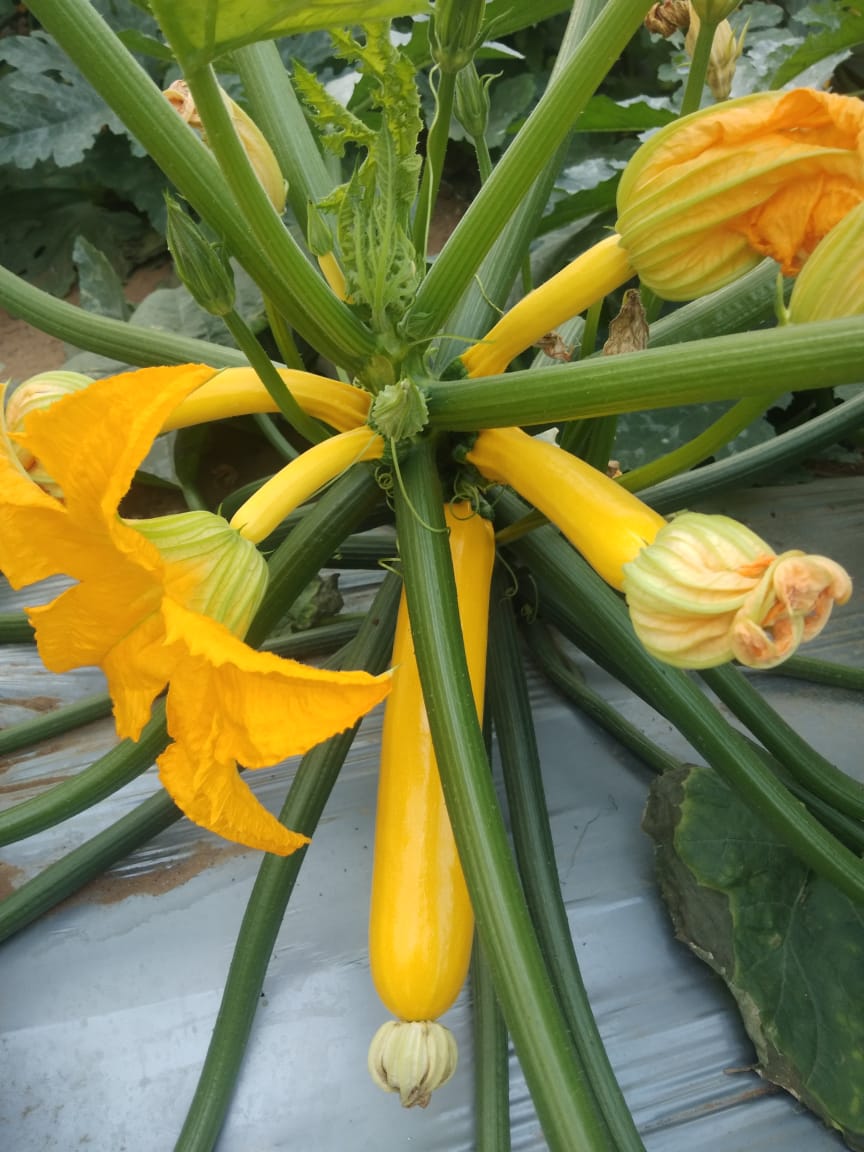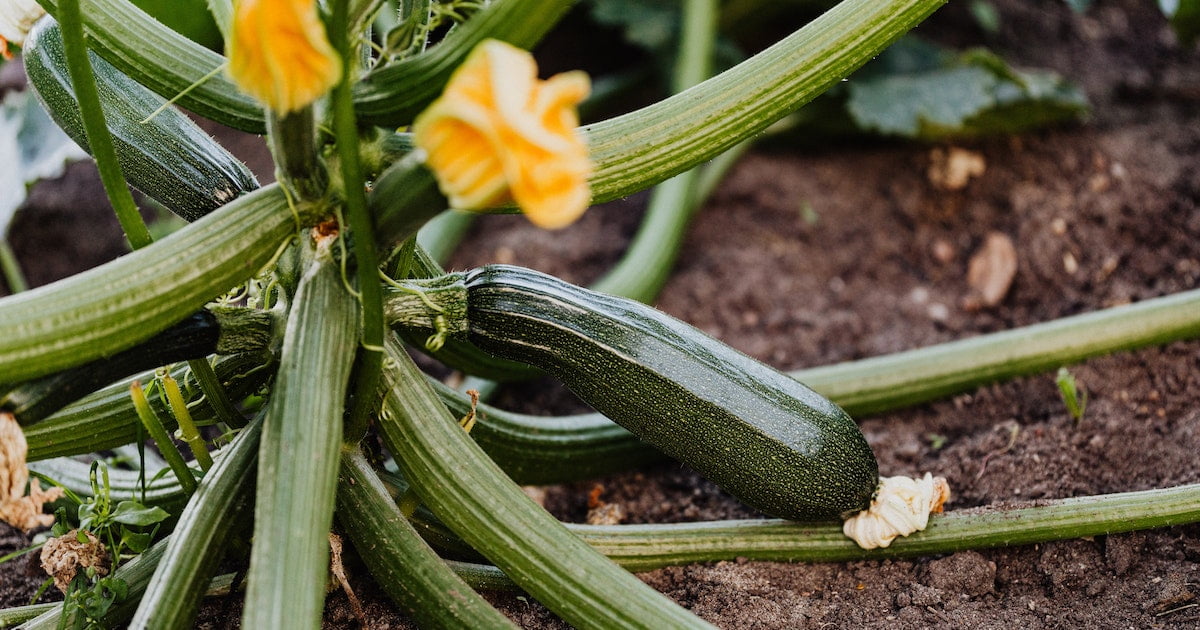Zucchini is an easy-to-grow exotic vegetable. Zucchini farming is a great option for farmers who wanted to start an exotic vegetable farming
You can use zucchini for cooking and eating purposes. It is treated as a vegetable and is usually used in savory dishes. It is also called summer squash.
This vegetable is available in three colors: yellow, green, or light green. The shape of zucchini vegetables is like a cucumber, and the best time to use this vegetable is when it is immature and measures 6 to 8 inches long before the seeds come.
Zucchini is a technical fruit and a variety of summer squash. It is harvested while it is immature.
Zucchini is rich in vitamins, minerals, and plant compounds. It has many benefits like health benefits, ranging from improved digestion to a lower risk of heart disease. It can improve heart health. Zucchini fruit is high in fiber. And it also helps to reduce the risk of diabetes. Some people also enjoy zucchini Raw, which works great in salads. zucchini is effective in the treatment of diabetes.
Zucchini is also a source of vitamin C, B6, and vitamin A and is available in small amounts. Minerals also include manganese, potassium, and small amounts of magnesium and phosphorus. Zucchini vegetable is the best grilled of the summer season.
Zucchini has a slightly bitter, mild flavor and is somewhat sweet.

Climatic Requirements for Zucchini Farming
Zucchini is a summer crop grown in much direct sunlight. The ideal temperature is 18°C to 24°C.
Zucchini like warm weather. It produces mature fruits in frost-free weather and requires this weather for at least 50 days.
Zucchini plants are healthy when the growing site provides direct sunlight for at least 6 hr. Zucchini seeds germinate at 28 to 32 °C, 22 to 29 °C temperature is suitable for zucchini nursery plant.
Soil requirement for zucchini cultivation
Loamy, well-drained soil is best for growing zucchini.
Those soils are best for zucchini plants with a high organic matter and a 6.5 pH. Use only organic fertilizers on plants and, most important, test your soil every few years to check its health or well balanced.
The seedling will appear independent in loose soil. Zucchini plants are heavy feeders, so the soil must be wealthy in organic materials. Early seed sowing may be done on light soil, and heavier soils are suited to planting that will be produced late in the season.
Nursery Making for zucchini farming
The seedlings of zucchini can also be grown in a greenhouse in plastic pro trays.
Between mid-January and mid-February, when the nighttime temperature is very low in northern areas of the country, seedlings that are 28–32 days old and at the fourth leaf stage are transplanted under covers or low plastic tunnels in the open field.
Depending on the needs of the region, a nursery of zucchini can also be raised in polythene bags in extremely basic and affordable protected structures like walk-in tunnels or locally accessible plastic trays in soil-less media.
For full-season production, it can be transplanted as early as December. This crop can be harvested in the first week of February and sell for a very high price on the market.
Zucchini varieties
There are many varieties of zucchini in the world. The best type of zucchini is given below.
| Black beauty | It is an early-growing variety and has high yields. |
| Green Machine | This variety takes time to mature in 45 days |
| Costata romanesco | it tastes like a possum and is nutty-flavored Italian zucchini. It will be ready to harvest in 52 days. |
| Ambassador | It is an early-growing variety and dark green. It will be ready to harvest in 50 days. |
| Gold rush | Cylindrical fruit and ready for harvest in 45 days. |
| French white | This variety is for small gardens and is ready for harvest in 50 days. |
| Eightball | It is dark green globe fruit and butter in taste and ready for harvest in 40 days. |
| Seneca | It will be ready for harvest in 42 days. |
| spacemiser | It is a high-yield variety. Green fruit can be harvested as baby squash and is ready for harvesting in 45 days. |
| Dunja | It is medium in size and dark green and ready to harvest in 47 days.It is medium in size and dark green and ready to harvest in 47 days. |
| Spineless beauty | It takes 46 days to mature. |
| Spineless perfection | 45 days to mature. Easy pick gold second |
Zucchini Plantation

Seed rate and plant spacing:
The seed rate for zucchini is 1-1.25 kg/acre; for summer squash farming, the seed rate is 2 kg per acre.
Sowing time:
The seed is sown in the last week of February or the first week of March when the night temperature comes to around 18 to 20 degrees Celsius. Nursery can be raised in a protected structure in plug trays of 3.5 cm cell size from December to February.
Plant spacing
Zucchini plants are grown around 1 meter apart and from 500 to 900 mm between plants in a row. This gives 7500-11000 plants per hectare.
A second system is to sow double rows of plants 750 mm apart with a pathway of about 1.4 meters between pairs of rows. And direct sowing seeds in level ground 1 inch deep and 2 -3 inches divided.
fertilizer Management
These are the most critical roles of manure and fertilizers. They give proper nutrients to the soil, which can help to grow healthy plants.
If you want your zucchini to grow organically, mix compost or well-rotted manure into the soil before planting. And you can also apply organic fertilizers. Zucchini plants are heavy feeders.
So they need enough nutrients to support that growth. Apply 1.5 to 2 quintals FYM at the time of field preparation and the NPK dose is 25 kg an acre
later stages of growth, 20 kg has to spry in 4 spilled doses through the therapy irrigation method.
After pollination, the ratio of NPK 13:0:45 is applied by drip irrigation.
We are applying 2 cups of about 16-16-8 fertilizer per 50 square feet of land and the benefit of the zucchini plant is additional nitrogen once it produces vines and flowers.
Irrigation Management
Zucchini needs regular moisture to produce large, problem-free harvests.
Water is essential for plants. And in zucchini plants, give water 1 to 2 inches when the soil feels dry.
Generally, give water once a week when the atmospheric conditions are cold and increase to two or three times per week during hot, arid weather.
And also, remind that don’t overwater zucchini plants. Otherwise, the plants grow very slowly, with yellow leaves, and rot on the vine. Too much water washes nutrients out of the soil and can leave the roots waterlogged. So giving the zucchini just sufficient water to thrive is often a challenge.
Plants need water during different stages like vegetative, flowering, and fruit set stages.
So sustenance the soil moisture. After sowing the seeds or planting, apply the first irrigation immediately.
Just irrigate once a week in the summer season and the rainy season. And regular irrigation can be applied in drought conditions for higher yield. And do not give water to the plants after fruit maturity.
Drip irrigation is best for water management if you want a well-maintained water supply. Drip irrigation is applying the right amount of water. And avoid subsurface watering.
Intercultural operations:
Zucchini needs to be weeded frequently.
Three weeding operations are necessary to keep the weeds under control and produce an economically viable yield from this crop; the first one can be done anywhere between 15 and 20 days after sowing.
Pest and disease management:
Insect-pest
Thrips
Slivered or bronzed foliage, stunted leaves, terminal shoots, and scarred malformed fruits are signs of heavily infested plants.
Silvering and flecking can be seen on the seedlings’ leaves as a result of thrips feeding damage.
Control:
- Use neem cake.
- Spray Ethion 50 EC @ 1 ml and dimethoate 30 EC @ 2 ml alternatively.
Fruit fly
Injured fruit is pierced by the adult fly, which then lays eggs beneath the epidermis. Fruits are fully harmed when maggots that hatch from the eggs burrow deep into the fruit pulp to feed. Fruits that have been attacked wilt and fall to the ground.
Control:
- To destroy pupae, plough the field deeply during the hot months.
- Eliminate and destroy the diseased fruits.
- Apply name cake @ 250 kg/ha right away after germination, repeat during flowering, and then 10 days after flowering, spray neem soap 1% or pnse 4%.
- Use 0.5 ml/liter of intoxicating water to mist the crop.
Red spider mite
On the underside of the leaves, there are tiny insects called mites that are coated in delicate webs. The upper surface of the leaves develops yellowish flecks as a result of nymphs and adults sucking the cell sap from delicate areas. The outcome is that the leaf dries up and turns pale.
Control:
Spray neem oil or Pongamia soap at 1% on a lower surface thoroughly.
Alternately spray dimethoate 30 EC @ 2 ml, Ethion 50 EC @ 1 ml .
Red pumpkin beetle
The host plants wilt and die as a result of the red pumpkin beetle grubs in the soil feeding on the stem and underground roots of the host plants.
In addition to perforation and uneven holes, the adult beetles also cause seedling mortality when they feed on cotyledonary leaves and leaf lamina after emerging from the soil.
By making tiny holes in the fruit, they might also harm it.
Control:
- Manually Collect and destroy the pest mechanically if the population is low..
Disease:
Downy mildew
The primary symptom is the development of angular yellow dots on the upper surface of the leaves along with a surface mould growth that is greyish.
The dots get larger as the leaves turn yellow and eventually die. The lower surface of the leaves develops a downy, light grey to purple mildew during periods of moisture. And the leaves quickly ascend and darken.
Control:
- After harvest, get rid of the plant debris.
- Keep all wild cucurbit weeds out of the field.
- When applying irrigation, stay away from flood irrigation.
Powdery mildew:
On the stems, petioles, and leaves, there are spots or patches that are white or grey. Shriveled leaves later turn into defoliation. In severe situations, plants become chlorotic and stunted.
The fruit shrank in size. High temperatures and dry weather encourage the spread of the disease.
Control:
- After harvest, get rid of the plant debris.
- Eliminate the weeds, especially the pathogen-carrying ones.
- When applying irrigation, stay away from flood irrigation.
Anthracnose
Starting with Venus, round reddish-brown dots start to develop on leaves. The leaves may become blighted as these dots combine. These spots have falling centres, giving them a shot appearance. On stems and petioles, there are elongated brown stripes.
Fruits that have been impacted by this condition have brown to lack water-soaked depressed circular patches that turn ash coloured in the middle.
Control:
- Utilize a non-host crop after a protracted crop rotation.
- After harvest, immediately plough the fields.
- Thiram, also known as dithane M42, should be applied to the seed (2g/kg).
- Keep all wild cucurbit weeds out of the field.
- Apply diofolatan (0.2%) and benomyl (0.1%) to the crop.
Vegetable marrow mosaic virus, cucumber mosaic virus, papaya ring spot virus-W or watermelon mosaic virus,
Control :
- Spray 1-2% of oils like paraffin, castor, or groundnut on the crop.
- Use hot air at 70 degrees Celsius for two days or no water at 50 degrees Celsius for 60 minutes to treat the seed.
Harvesting
When you harvest your zucchini :
- When zucchini reaches 4 to 6 inches in length, it is the right stage for harvesting.
- Zucchini is an annual plant so it will live only for one growing season, between 90 and 150 days, depending on location, growing conditions, and varieties.
- After sowing in 40 to 50 days, most zucchini varieties are ready for first picking. It develops quickly after flowering, so you can harvest it before the zucchini hardens.
- You can pick zucchini every second day to maintain the desired fruit size because the fruit becomes too large due to its rapid growth.
- Regular harvesting encourages the plant to continue fruit production, so you should be able to harvest zucchini many times in one growing season.
How to harvest zucchini:
To harvest a zucchini, use a sharp knife or scissors to cut the stem one or two inches from the fruit. Also, pour in zucchini plants.
Yield per acre of zucchini plants:
- One zucchini plant can produce 40 fruits a season.
- The average result is approximately 8000kg/acre.
- Generally, each plant has 5 to 25 pounds of yellow squash during the growing season.
- One zucchini plant can have between 3 to 10 pounds of produce. It depends on how you take care of the plant.
- You can see zucchini within 35 to 55 days of it being planted.
Conclusion:
Zucchini is a kind of summer squash, which means the fruit has soft, edible skin. Summer squash is fast-growing and can be harvested in 35 days.
As well as the number of fruits produced per square meter. The crop is cultivated for its tender fruits, which are available in different shapes, colors, and sizes for use as cooked vegetables.
It is one of the earliest cucurbits to reach the market, and its cultivation is confined to areas near markets.




Thank you Mr Sawant for sharing such wonderful information. This sounds like very interesting info. Can we connect to discuss in detail?
sure, Please contact us- [email protected]